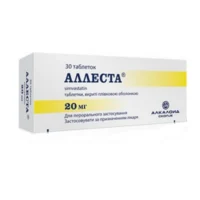Description
Lansoprol Capsules 15 mg. №28
Ingredients:
Each Lansoprol capsule contains 15 mg of Lansoprazole.
Mechanism of Action:
Lansoprol is a proton pump inhibitor (PPI) that works by selectively inhibiting the H+/K+ ATPase enzyme system in the gastric parietal cells. This action leads to a reduction in the production of gastric acid by blocking the final step of acid secretion.
Pharmacological Properties:
Lansoprazole, the active ingredient in Lansoprol, is a substituted benzimidazole that binds covalently to the proton pump to inhibit acid secretion. It has a high specificity for the gastric H+/K+ ATPase enzyme and is rapidly metabolized in the liver.
Indications for Use:
Lansoprol is indicated for the treatment of gastroesophageal reflux disease (GERD), erosive esophagitis, gastric ulcers, duodenal ulcers, Zollinger-Ellison syndrome, and other conditions associated with excessive gastric acid secretion.
Contraindications:
Do not use Lansoprol if you have a known hypersensitivity to Lansoprazole or any other components of the formulation. Patients with severe hepatic impairment should also avoid its use.
Side Effects:
- Common side effects may include headache, diarrhea, abdominal pain, and nausea.
- Less common side effects can include dizziness, rash, and altered liver function tests.
- Rare but serious side effects may include severe allergic reactions, Clostridium difficile-associated diarrhea, and vitamin B12 deficiency with long-term use.
Usage Instructions:
The recommended dosage of Lansoprol is one 15 mg capsule taken orally once daily in the morning before a meal. Swallow the capsule whole with a glass of water and do not crush or chew it.
Benefits Compared to Analogues:
Lansoprol offers the advantage of once-daily dosing, providing sustained acid suppression and symptom relief. Its high specificity for the proton pump results in potent acid inhibition and effective management of acid-related disorders.
Suitable Patient Groups:
Lansoprol is suitable for use in adults, elderly patients, and adolescents over 12 years of age. It should be used with caution in patients with renal impairment and avoided in individuals with severe hepatic dysfunction.
Storage Conditions and Shelf Life:
Store Lansoprol capsules in their original packaging at room temperature below 25°C. Keep them away from moisture and sunlight. The shelf life of the product is indicated on the packaging and should not be exceeded.
Packaging Description:
Lansoprol capsules are packed in blister packs to ensure individual unit protection. Each box contains 28 capsules. The packaging is designed to maintain the stability and integrity of the product.
Clinical Evidence and Proven Effectiveness:
Lansoprol has been extensively studied in clinical trials, demonstrating its efficacy in the treatment of various acid-related disorders. Research published in the American Journal of Gastroenterology highlighted Lansoprazole’s superior effectiveness in healing erosive esophagitis compared to other proton pump inhibitors.





